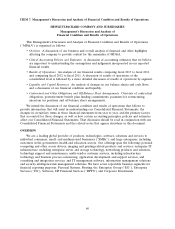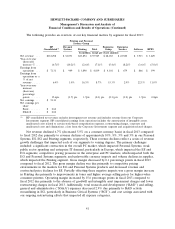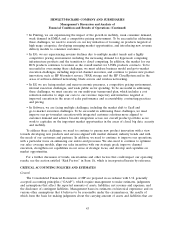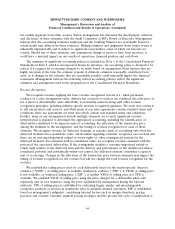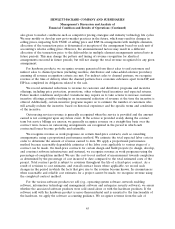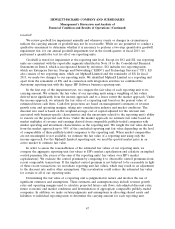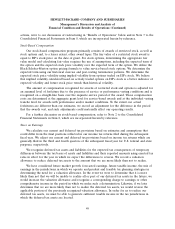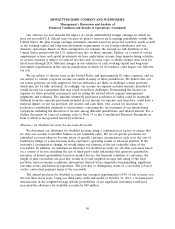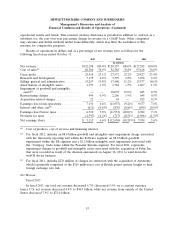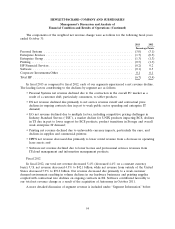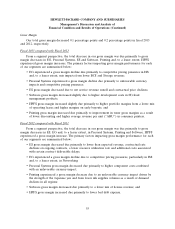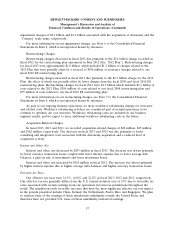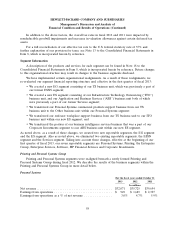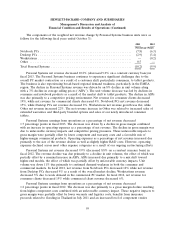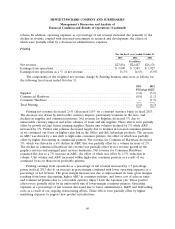HP 2013 Annual Report Download - page 58
Download and view the complete annual report
Please find page 58 of the 2013 HP annual report below. You can navigate through the pages in the report by either clicking on the pages listed below, or by using the keyword search tool below to find specific information within the annual report.HEWLETT-PACKARD COMPANY AND SUBSIDIARIES
Management’s Discussion and Analysis of
Financial Condition and Results of Operations (Continued)
Our effective tax rate includes the impact of certain undistributed foreign earnings for which we
have not provided U.S. federal taxes because we plan to reinvest such earnings indefinitely outside the
United States. We plan foreign earnings remittance amounts based on projected cash flow needs as well
as the working capital and long-term investment requirements of our foreign subsidiaries and our
domestic operations. Based on these assumptions, we estimate the amount we will distribute to the
United States and provide the U.S. federal taxes due on these amounts. Further, as a result of certain
employment actions and capital investments we have undertaken, income from manufacturing activities
in certain countries is subject to reduced tax rates and, in some cases, is wholly exempt from taxes for
fiscal years through 2024. Material changes in our estimates of cash, working capital and long-term
investment requirements in the various jurisdictions in which we do business could impact our effective
tax rate.
We are subject to income taxes in the United States and approximately 80 other countries, and we
are subject to routine corporate income tax audits in many of these jurisdictions. We believe that our
tax return positions are fully supported, but tax authorities are likely to challenge certain positions,
which may not be fully sustained. Accordingly, our income tax expense includes amounts intended to
satisfy income tax assessments that may result from these challenges. Determining the income tax
expense for these potential assessments and recording the related effects requires management
judgments and estimates. The amounts ultimately paid upon resolution of audits could be materially
different from the amounts previously included in our income tax expense and, therefore, could have a
material impact on our tax provision, net income and cash flows. Our accrual for uncertain tax
positions is attributable primarily to uncertainties concerning the tax treatment of our international
operations, including the allocation of income among different jurisdictions, and related interest. For a
further discussion on taxes on earnings, refer to Note 13 to the Consolidated Financial Statements in
Item 8, which is incorporated herein by reference.
Allowance for Doubtful Accounts for Accounts Receivable
We determine our allowance for doubtful accounts using a combination of factors to ensure that
we state our account receivables balance at net realizable value. We record specific provisions for
individual accounts when we become aware of specific customer circumstances, such as in the case of
bankruptcy filings or a deterioration in the customer’s operating results or financial position. If the
customer’s circumstances change, we would adjust our estimate of the net realizable value of the
receivables. In addition, we maintain an allowance for doubtful accounts for all other customers based
on a variety of factors, including the use of third-party credit risk models that generate quantitative
measures of default probabilities based on market factors, the financial condition of customers, the
length of time receivables are past due, trends in overall weighted-average risk rating of the total
portfolio, macroeconomic conditions, information derived from competitive benchmarking, significant
one-time events and historical experience. The past due or delinquency status of a receivable is based
on the contractual payment terms of the receivable.
The annual provision for doubtful accounts has averaged approximately 0.04% of net revenue over
the last three fiscal years. Using our third-party credit risk model at October 31, 2013, a 50-basis-point
deterioration in the weighted-average default probabilities of our significant customers would have
increased the allowance for doubtful accounts by $48 million.
50


